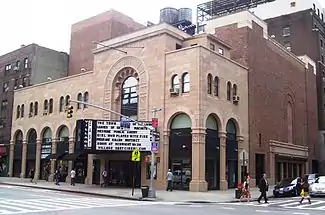Village East Cinema
The Village East Cinema is a movie theater in the East Village of Manhattan, New York City. One of New York's last remaining Yiddish theatre buildings, it is a New York City designated landmark[1] and is listed on the National Register of Historic Places.
 The Village East Cinema in 2010 | |

| |
| Former names | Louis N. Jaffe Theater, Yiddish Art Theatre, Yiddish Folks Theatre, Century Theatre, Phoenix Theatre, Gayety Theatre, Eden Theatre, Entermedia Theater |
|---|---|
| Address | 181-189 2nd Ave. |
| Location | New York City |
| Coordinates | 40°43′51.3″N 73°59′10.4″W |
| Public transit | New York City Subway: |
| Owner | City Cinemas (Reading International) |
| Type | Yiddish theatre |
| Screens | 7 |
| Current use | Movie theatre |
| Construction | |
| Architect | Harrison Wiseman |
| Website | |
| www | |
Originally named the Louis N. Jaffe Theater (also called the Yiddish Art Theatre (after its first tenant) and later the Yiddish Folks Theatre), the structure was built in 1925-26 by Louis Jaffe, a developer and prominent Jewish community leader, at 12th Street and Second Avenue in the Yiddish Theatre District. Jaffe built the theatre to house Maurice Schwartz's Yiddish Art Theatre, which Schwartz had founded 1918 to present serious Yiddish drama and works from world literature in Yiddish.[1][2][3]
The theatre was designed in the Moorish Revival style by Harrison Wiseman; William Pogany consulted on the interior design. The design incorporated Moorish motifs with Judaic references (Yiddish writing outside the lobby and a large Star of David in the ornate dome remain to attest to the building's origins).[1][2][3][4][5]
In his new theatre, Schwartz continued to produce shows, including a production of "Yoshe Kalb" which ran for 300 performances. According to legend, Walter Matthau briefly worked at the theatre's concession stand as a youth.[2][4][5]
The Yiddish Arts Theatre continued at least into 1936, but by the late 1930s the building was a movie theatre, the Century Theatre. It closed for a while in the 1940s, reopening as a 1,082-seat movie theatre, the Stuyvesant Theatre.[5][6]
Around 1953 Norris Houghton and Edward Hambleton bought the theatre (which was then closed) and renamed it the Phoenix Theatre. The Phoenix Theatre was a pioneering project in the development of off-Broadway, with a different approach to legitimate theatre than found on Broadway. The first production was Sidney Howard's play "Madam, Will You Walk?", which opened on December 1, 1953, starring Hume Cronyn and Jessica Tandy; later that season Montgomery Clift starred in The Seagull.
In the following years, the Phoenix Theatre mounted more productions featuring notable figures of the theatre both on stage and behind it. The Phoenix Theatre moved to a new location in 1961.
Ann Corio then mounted her successful nostalgic review This Was Burlesque at the theatre, beginning in 1962. Corio later took her show on the road. From 1965 to 1969, the building was the Gayety Theatre, a more raunchy burlesque house, and the only one in Manhattan at that time. The Gayety Theatre was used for the interior theatre shots in the film The Night They Raided Minsky's. After this, the theatre operated as the Eden Theatre and hosted off-Broadway shows, including Grease and Joseph and the Amazing Technicolor Dreamcoat before those musicals went on to Broadway, and the controversial Oh! Calcutta!. From 1978 to 1984 the theatre operated as the Entermedia Theater.[1][6][7][8]
In 1991 the theatre (which was no longer in use) was converted back to a movie theatre, the Village East Cinema (owned by City Cinemas, a branch of Reading International), which shows a mixture of Hollywood productions and indie films. The main auditorium seats 1,200, and there are four small screening rooms in the basement, each seating under 200 people, and two other screens in the former backstage area. The Village East Cinema also shows films which originally opened at the Angelika Film Center, an arthouse chain which is also an arm of Reading International. The theatre was extensively renovated and restored in 2015.[1][5][9][10]
References
- James Murray and Karla Murray (January 27, 2017). "The Urban Lens: Inside the Village East Cinema, one of NY's last surviving 'Yiddish Rialto' theaters". 6sqft. Retrieved March 5, 2017.
- Annie Cofone (June 8, 2012). "Strolling Back Into the Golden Age of Yiddish Theater". The Local – East Village. Retrieved March 5, 2017.
- Amanda Seigel (March 18, 2014). "The Yiddish Broadway and Beyond". New York Public Library. Retrieved March 5, 2017.
- Michelle Young (September 19, 2010). "Village East Cinema, a Moorish Revival Movie Theater in the East Village". Untapped Cities. Retrieved March 5, 2017.
- Ross Melnick (December 1, 2015). "City Cinemas Village East". Cinema Treasures. Retrieved March 5, 2017.
- Jeremiah Moss (January 31, 2011). "Village East". Vanishing New York. Retrieved March 5, 2017.
- Jeremia Moss (June 25, 2008). "Finding Lost Houston". Vanishing New York. Retrieved March 5, 2017.
- "Entermedia Theater". Lortel Archives (Internet Off-Broadway Database). Retrieved March 6, 2017.
- "Cinema Info – Overview". City Cinemas. Retrieved March 5, 2017.
- "City Cinemas Village East Cinema". The Village Voice. NYC & Company. Retrieved March 5, 2017.
External links
| Wikimedia Commons has media related to Louis N. Jaffe Art Theater. |